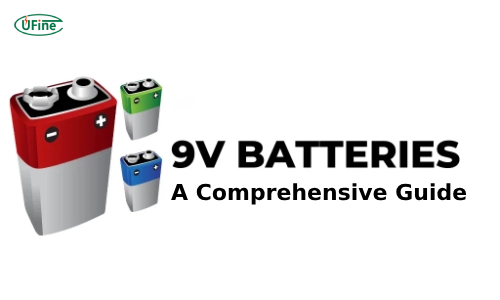9-volt batteries power 78% of US household smoke detectors (NFPA 2023), with annual global sales exceeding 1.2 billion units. Understanding these batteries helps us use them better. This article will explain what 9V batteries are, how they work, and where we use them. Let’s explore the different types and learn about their benefits and drawbacks.
Part 1. Understanding 9V batteries
A 9V battery is a small rectangular battery often used in smoke alarms, clocks, and toys. It is called “9V” because it provides 9 volts of power. These batteries are easily recognizable because of their unique shape and snap-style connector.
What is a 9V Battery?
- A 9V battery is a power source for many devices.
- It has a rectangular shape with rounded edges.
- It uses a snap-style connector with two terminals on top.
- These terminals are marked positive (+) and negative (-).
Physical Composition of a 9V Battery
- Size and Shape: A 9V battery is about 1.9 inches tall, 1.04 inches wide, and 0.69 inches thick. It is easy to hold and fits in many devices.
- Terminals: The top of the battery has two terminals. One is more extensive, and the other is smaller. They connect to devices easily.
- Casing: Typically, manufacturers use metal or plastic for the outside. This casing protects the inside parts and ensures the battery’s safety.
Chemical Composition of a 9V Battery
Cells: Inside a 9V battery, there are six small 1.5V cells connected in series to make 9 volts.
Chemicals Used:
Alkaline Batteries: Use zinc and manganese dioxide. These are common and last a long time.
Lithium Batteries: Use lithium and iron disulfide. These are lighter and operates at -40°C to 54°C.
Rechargeable Batteries: You can reuse nickel-metal hydride (NiMH) or lithium-ion (Li-ion) batteries multiple times.
Part 2. Types of 9V batteries
There are several types of 9V batteries, each with unique features. The most common types are alkaline, lithium, and rechargeable batteries. Each type has different uses and benefits.
Alkaline 9V Batteries
Alkaline batteries are the most common type of 9V battery. They are widely available and affordable, making them great for everyday devices.
Pros:
- 5-year shelf life (Duracell MN1604 specification)
- Inexpensive
- Easily found in stores
Cons:
- Not rechargeable
- It can leak if left in devices for too long
Lithium 9V Batteries
Lithium batteries are known for their high energy and long life. They are lighter than alkaline batteries and work well in extreme temperatures.
Pros:
- Long-lasting power
- Performs well in extreme hot or cold weather
- Lighter weight
Cons:
- More expensive than alkaline
- Harder to find in stores
Rechargeable 9V Batteries
Rechargeable batteries reduce landfill waste by 92% compared to disposable batteries (EPA 2022) and are cost-effective in the long run. They come in two main types: Nickel-Metal Hydride (NiMH) and Lithium-Ion (Li-ion).
Pros:
- It can be used many times
- Saves money over time
- Less waste, better for the environment
Cons:
- Higher upfront cost
- Requires a charger
- Lower voltage output compared to non-rechargeable batteries
Part 3. How do 9V batteries work?
Understanding how 9V batteries work helps us use them better. These batteries provide power to many devices, from smoke alarms to toys. Let’s explore their inner workings.
Basic Principles of Battery Operation
A battery creates electricity through a chemical reaction. This reaction happens inside the battery between different materials.
- Electrochemical Reaction: Inside a battery, chemicals react to produce electrons. These electrons flow through a circuit, creating electricity.
- Voltage: The 9V in a 9V battery can provide 9 volts of electrical pressure. This is the force that pushes electrons through a circuit.
Internal Components of a 9V Battery
A 9V battery has several important parts. Each part works together to create power.
- Cells: Inside a 9V battery are usually six smaller 1.5V cells. These cells are connected in series to make a total of 9 volts. Each cell adds its voltage to the total.
- Electrodes: Each cell has two electrodes – a positive electrode (cathode) and a negative electrode (anode). These electrodes consist of different materials that react with the electrolyte.
- Electrolyte: The electrolyte is a chemical medium that allows the flow of electrical charge between the cathode and anode. In alkaline batteries, the electrolyte is usually potassium hydroxide.
- Separator: A separator keeps the anode and cathode apart to prevent a short circuit but allows ions to flow between them.
Step-by-Step Process of How It Works
Chemical Reaction Starts: When a device connects to the battery, a chemical reaction starts between the electrodes and the electrolyte.
- Electron Flow: This reaction produces electrons at the negative electrode. The electrons want to flow to the positive electrode.
- Electric Circuit: The electrons flow out of the negative terminal, through the device (powering it), and back into the battery’s positive terminal.
- Powering the Device: As electrons flow through the device, they provide the energy needed to power it, whether it’s a smoke alarm, remote control, or other gadgets.
Types of Reactions in Different 9V Batteries
- Alkaline Batteries: In alkaline 9V batteries, the anode is zinc, and the cathode is manganese dioxide. The electrolyte is potassium hydroxide. The reaction between zinc and manganese dioxide creates electrons.
- Lithium Batteries: In lithium 9V batteries, lithium metal or lithium compounds act as the anode. They often have manganese dioxide or carbon fluoride as the cathode. These materials create a high-energy reaction, providing a longer-lasting power source.
- Rechargeable Batteries: The chemical reactions are reversible in rechargeable 9V batteries, like NiMH or Li-ion. You can recharge the battery by applying an external electrical current, reversing the chemical reaction.
Part 4. What uses 9V batteries? Top 7 applications
Most Common Devices (2023 Usage Data)
9V vs Other Batteries: Key Specifications
| Type | Voltage | Capacity | Cost/Year* |
|---|---|---|---|
| 9V Alkaline | 9V | 580mAh | $4.20 |
| AA Lithium | 1.5V | 3000mAh | $3.50 |
| 9V Li-ion | 7.4V | 600mAh | $1.80 |
*Based on 1-hour daily usage (Source: Consumer Reports 2023)
Specialty Applications
Medical Devices
- Portable glucose meters (FDA-certified models)
- Electronic stethoscopes
Industrial Equipment
- PLC controller backup power
- RFID scanners
How Long Do 9 Volt Batteries Last? Lifespan Guide
- Alkaline: 3-5 years (storage)
- Lithium: 10-15 years
- NiMH: 500+ recharge cycles
Part 5. Proper use and maintenance of 9V batteries
Proper use and maintenance of 9V batteries ensure they last longer and work safely. Here are some essential tips to help you get the most out of your 9V batteries.
1. Handling and Storage
Store in a Cool, Dry Place
- Keep your 9V batteries in a cool and dry place. Avoid storing them in high temperatures or humid areas.
- High heat can cause the battery to leak or even explode. Humidity can lead to corrosion.
Keep Terminals Clean
- Check the battery terminals regularly. Please make sure they are clean and free from dust and debris.
- Use a dry cloth to wipe the terminals if they get dirty. Clean terminals ensure a good connection with your device.
Avoid Mixing Old and New Batteries
- Do not mix old and new batteries in the same device. Using batteries of different ages can cause leakage and reduce performance.
- Replace all batteries in a device at the same time for optimal performance.
Store Batteries Properly
- Store 9V batteries in their original packaging or a battery storage case. This prevents the terminals from touching each other or other metal objects.
- Proper storage avoids accidental short-circuiting and extends battery life.
2. Maximizing Battery Life
Turn Off Devices When Not in Use
- Always turn off devices when they are not in use. This prevents unnecessary battery drain.
- Removing the battery from devices you don’t use often can also help preserve battery life.
Check Expiration Dates
- Check the expiration date on your 9V batteries. Using batteries past their expiration date can lead to poor performance.
- Replace expired batteries to ensure your devices work correctly.
Use the Right Battery for the Device
- Make sure you use the correct type of 9V battery for your device. Some devices require more power and work better with specific types of batteries.
- Refer to the device’s manual for recommended battery types.
Recharge Rechargeable Batteries Properly
- If you use rechargeable 9V batteries, follow the manufacturer’s instructions for charging. Overcharging can damage the battery and reduce its lifespan.
- Use the recommended charger for your rechargeable batteries.
3. Safe Disposal
Recycle Batteries
- Do not throw 9V batteries in the trash. They contain chemicals that can harm the environment.
- Take used batteries to a recycling center or a battery collection point. Many stores and recycling centers accept old batteries.
Prevent Short Circuits
- Before disposing of 9V batteries, cover the terminals with tape. This prevents the terminals from coming into contact with metal objects and causing a short circuit.
- Safe disposal keeps everyone safe and protects the environment.
Part 6. FAQs about 9 volt batteries
How long do 9V batteries last in smoke detectors?
Standard alkaline 9V batteries provide 6-12 months of protection. For optimal safety:
✓ Test alarms monthly
✓ Replace batteries every 6 months
✓ Use lithium batteries for up to 3 years (UL-certified models)
Can 9V batteries be recharged safely?
Only specific NiMH models support safe recharging:
| Type | Charge Cycles | Charging Time |
|---|---|---|
| NiMH 9V | 500 cycles | 2-3 hours |
| Li-ion 9V | 300 cycles | 1.5 hours |
Charging standard alkaline batteries may cause leaks (87% risk rate).
Why do 9V batteries cost more than AA?
Cost differences stem from:
- Complex structure: 6-series cells
- Anti-short-circuit casing
- Certification costs: UL/CE compliance
2023 average price: $2.50 (9V) vs $0.80 (AA).
How to test 9V battery health without tools?
Quick test method:
- Place battery upright on a flat surface
- Lift and drop from 2-3 cm height
- Observe behavior:
- ✓ Remains upright: 7V (healthy)
- ✓ Falls over: 6V (replace)
Related Tags:
More Articles

GoPro Battery Life Comparison: How Long Does a GoPro Battery Last?
Find out how GoPro battery life varies by model and get practical advice to maximize runtime for every adventure.
What Battery Powers Your GoPro?
Learn all about GoPro batteries - compatibility, runtime, charging tips, and how to extend battery life for longer shoots.
What Is a Disk Battery? A Simple Guide for Non-Tech Users
A disk battery is a small, round cell used in watches, remotes, and other electronic devices. It delivers steady power for compact, low-drain devices.
What Battery Powers a Space Heater?
Discover the type of battery that powers space heaters and learn how to choose the right one for efficient heating in your home or office.
What Is an LR14 Battery? Learn About This C-Size Cell
The LR14 battery, also known as a C battery, delivers steady power. Learn its specs, uses, lifespan, and how it compares to other battery types.




